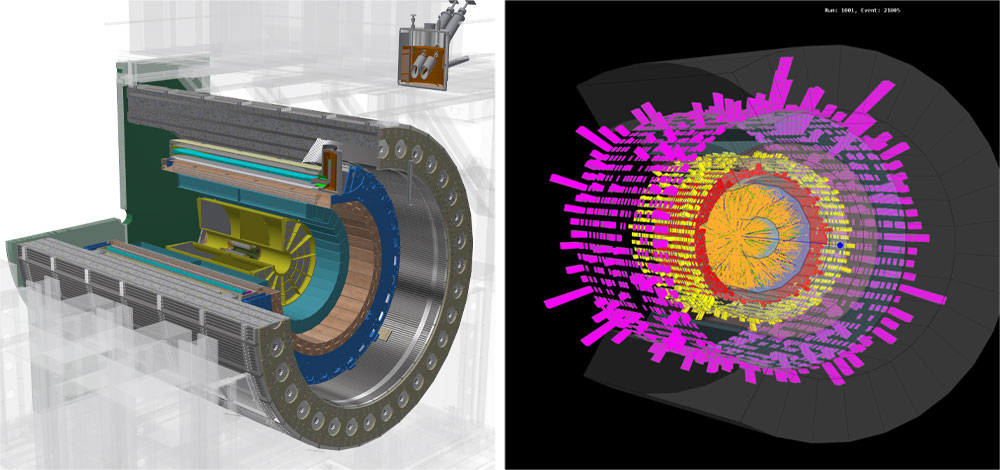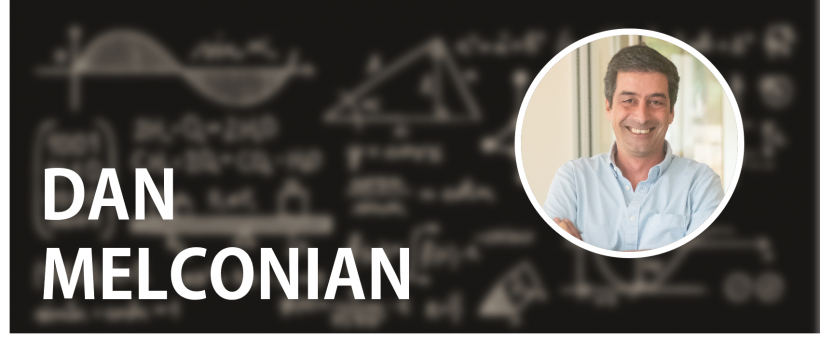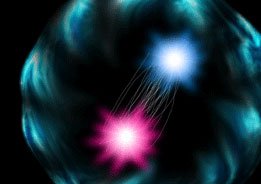Protons and neutrons orbit atomic nuclei in shells with caps on how many protons or neutrons they can hold. Full shells mean stable, compact nuclei. Physicists call the number of protons or neutrons in a “magic” numbered full shell. New research shows that a previously reported “magicity” for number 32 does not appear in neutron-rich potassium isotopes.
Tag: Nuclear Physics
Results from Search for ‘Chiral Magnetic Effect’ at RHIC
Physicists from the STAR Collaboration of the Relativistic Heavy Ion Collider (RHIC), a U.S. Department of Energy (DOE) Office of Science user facility for nuclear physics research at DOE’s Brookhaven National Laboratory, presented long-awaited results from a “blind analysis” of how the strength of the magnetic field generated in certain collisions affects the particles streaming out.
Postdoc Picks at the Three-Particle Problem
Andrew Jackura wants to know what we’re made of. Now, as the winner of the 2021 Jefferson Science Associates (JSA) Postdoctoral Prize, he’ll get the chance to find out. Jackura is a postdoctoral research scientist at Old Dominion University and a scientific user at the U.S. Department of Energy’s Thomas Jefferson National Accelerator Facility. His research focuses on the strong nuclear force, the fundamental force responsible for keeping all ordinary matter in the universe together, including us.
Thesis Prize Winner Targets a Proton Puzzle
The proton was discovered just over a hundred years ago and has been intensely studied ever since. Yet, there’s still more to learn about this important building block of the visible universe. Now, work toward a better understanding of the proton carried out at the Department of Energy’s Thomas Jefferson National Accelerator Facility has earned Weizhi Xiong the 2020 Jefferson Science Associates (JSA) Thesis Prize.
Collisions of Light Produce Matter/Antimatter from Pure Energy
Scientists studying particle collisions at the Relativistic Heavy Ion Collider have produced definitive evidence for two physics phenomena predicted more than 80 years ago: that matter/antimatter can be generated directly from collisions of photons and that a magnetic field can bend polarized light along different paths in a vacuum.
EIC Center at Jefferson Lab Announces Research Awards
The Electron-Ion Collider Center at the Department of Energy’s Thomas Jefferson National Accelerator Facility (EIC Center at Jefferson Lab) has announced the winners of six international fellowships to help advance the science program of the Electron-Ion Collider (EIC).
Scientists Further Their Investigation into the Origin of Elements in the Universe
The slow neutron-capture process (the s-process) in nucleosynthesis results in about half of the elements heavier than iron in the universe. Two important reactions in the s-process are Neon-22 (alpha, gamma) and Neon-22 (alpha, neutron), which affect the abundances of elements such as Selenium, Krypton, Rubidium, Strontium, and Zirconium. Researchers recently used two indirect methods to study the reactions.
Using snakes to monitor Fukushima radiation
Researchers placed tiny GPS trackers on rat snakes to track their movements at Fukishima
Watching the ultrafast dance moves of a laser plasma
Great leaps in science and technology have been propelled by recent advances in seeing fast evolving physical phenomena, as they happen. Femtosecond lasers from the infrared to the X-ray region have enabled us to ‘watch’, in real time, atoms dance…
PPPL selected for new public-private fusion partnerships
Advanced capabilities ranging from the innovative use of artificial intelligence (AI) to state-of-the-art computer codes have won the U.S. Department of Energy’s (DOE) Princeton Plasma Physics Laboratory (PPPL) its third straight round of DOE-sponsored public-private partnerships to help accelerate the…
Scientists created several samples of glasses for protection against nuclear radiation
Bismuth borate glasses were shown outperformance while compared with the commercial ones
Quantum phase transition discovered in a quasi-2D system consisting purely of spins
The study could have applications in spintronics and quantum computing; it was conducted by an international collaboration and published in Nature; its first author is a researcher at the University of São Paulo
Unlocking radiation-free quantum technology with graphene
“Heavy fermions” are an appealing theoretical way to produce quantum entangled phenomena, but until recently have been observed mostly in dangerously radioactive compounds. A new paper shows it is possible to make them in subtly modified graphene
Partnership contributes toward sharp eyes for MOLLER experiment
The MOLLER experiment has received additional grants totaling $9 million
New clues to why there’s so little antimatter in the universe
Imagine a dust particle in a storm cloud, and you can get an idea of a neutron’s insignificance compared to the magnitude of the molecule it inhabits.

sPHENIX Assembly Shifts into Visible High Gear
Brand new, state-of-the-art components for an upgraded 1000-ton particle detector are being installed at the U.S. Department of Energy’s (DOE) Brookhaven National Laboratory. Known as sPHENIX, the detector is a radical makeover of the PHENIX experiment, which first began taking data at the Lab’s Relativistic Heavy Ion Collider (RHIC) in 2000.
New clues to why there’s so little antimatter in the universe
Radioactive molecules are sensitive to subtle nuclear phenomena and might help physicists probe the violation of the most fundamental symmetries of nature.
University of Liverpool leads £1.17 million innovative future MSR reactor project
Liverpool leads £1.17 million innovative future MSR reactor project
Closing the gap on the missing lithium
Researchers account for some of the lithium missing from our universe
Argonne announces 2022 Maria Goeppert Mayer Fellows, honoring the legacy of the physics Nobel Laureate
Argonne’s Maria Goeppert Mayer is one of only four women to win the Nobel Prize in physics. Today, on her 115th birthday, Argonne announces the award of its 2022 Maria Goeppert Mayer Fellowship to four outstanding early-career doctoral scientists.
Department of Energy Announces $2.85 Million to Support Undergraduate Research Traineeships at HBCUs and other MSIs
Today, the U.S. Department of Energy awarded over $2.85 million with a focus on broadening and diversifying the nuclear and particle physics research communities through research traineeships for undergraduates from Historically Black Colleges and Universities and other Minority Serving Institutions.
Application of new scientific techniques for corrosion protection
The overall growth of the Industry 4.0 and subsequent demand for new innovative materials opens a new field of mechanism to control premature degradation of the material. This book entitled ‘Corrosion Science-Modern Trends and Applications’ with twelve high-quality chapters provided…
Physicist wins early career grant to study nuclear physics, quantum phenomena
The U.S. Department of Energy has selected Iowa State’s Srimoyee Sen for an early career award that will help her study nuclear physics and quantum phenomena. The research could lead to the discovery of new materials that could one day contribute to speedy quantum computing or other applications.
Sofia Quaglioni: Then and Now / 2011 Early Career Award Winner
As the Deputy Group Leader of the Nuclear Data and Theory Group at Lawrence Livermore National Laboratory, Sofia Quaglioni is contributing to a unified understanding of the structure and lower-energy reactions of light nuclei.
Developing the novel joint technique for copper alloy
This highly contributes to producing the efficient heat removal component for fusion reactor
Australian researchers create quantum microscope that can see the impossible
In a major scientific leap, University of Queensland researchers have created a quantum microscope that can reveal biological structures that would otherwise be impossible to see. This paves the way for applications in biotechnology, and could extend far beyond this…
Machine Learning System Improves Accelerator Diagnostics
A machine learning system is helping operators resolve routine faults at the Continuous Electron Beam Accelerator Facility (CEBAF). The system monitors the accelerator cavities, where faults can trip off the CEBAF. The system identified which cavities were tripping off about 85% of the time and identified the type of fault about 78% of the time.
Wayne State physics professor awarded DOE Early Career Research Program grant
Chun Shen, Ph.D., assistant professor of physics and astronomy in Wayne State University’s College of Liberal Arts and Sciences, was awarded a five-year, $750,000 award from the U.S. Department of Energy’s Early Career Research Program for his project, “Quantitative Characterization of Emerging Quark-Gluon Plasma Properties with Dynamical Fluctuations and Small Systems.”
THOR: Driving collaboration in heavy-ion collision research
As an expansive platform for collaboration between different research groups, the THOR COST Action has enabled hundreds of physicists studying the aftermath of high-energy collisions between heavy ions to improve their predictions
New Technique Studies the Structure of Exotic Hadrons
Scientists don’t know how exotic hadrons with a larger number of quarks are structured—are they tightly bound hadrons or a compound of two hadrons similar to molecules? Now, scientists have developed a new technique to identify the nature of the χc1(3872, a four-quark hadron. This is the first time scientists have discovered the structure of a particle by observing how it interacts with nearby particles.
DOE names six Argonne scientists to receive Early Career Research Program awards
Six Argonne scientists receive Department of Energy’s Early Career Research Program Awards.
Signs of “Turbulence” in Collisions that Melt Gold Ions
A new analysis of collisions of gold ions shows signs of a “critical point,” a change in the way one form of matter changes into another. The results hint at changes in the type of transition during the shift from particles to the quark-and-gluon “soup” that filled the early universe. This helps scientists understand how particles interact and what holds them together.
Small modular reactors competitive in Washington’s clean energy future
New report finds a role for small modular reactors in the Pacific Northwest’s energy market
NUCLEUS – 2021
The LXXI International conference “NUCLEUS – 2021. Nuclear physics and elementary particle physics. Nuclear physics technologies”
Scientists to present new findings on atoms, molecules, and optics
Quantum choreography, ultraprecise clocks, memory boosters, and related research will debut at the 2021 DAMOP Annual Meeting
Researchers develop advanced model to improve safety of next-generation reactors
The model can better predict the physical phenomenon inside of very-high-temperature pebble-bed reactors
Scientists created building materials effectively protecting from radiation
Bricks made of new materials are cheaper and more environmentally friendly than analogues made of lead and other materials
Searching for the Origins of Presolar Grains
Some meteorites contain microscopic grains of stardust created by nucleosynthesis before our solar system existed. Many grains contain sulfur isotopes that are clues to the grains’ origins in novae and supernovae. Sulfur production from nucleosynthesis depends on the prior production of argon-34. Scientists created and studied argon-34 and established criteria for determining whether particular grains originated in novae or supernovae.
Nuclear terrorism could be intercepted by neutron-gamma detector that pinpoints source
Scanning technology aimed at detecting small amounts of nuclear materials was unveiled by scientists in Sweden today, with the hope of preventing acts of nuclear terrorism. Bo Cederwall, a professor of physics at KTH Royal Institute of Technology, says the…
Department of Energy Announces $10 Million for Research on Quantum Information Science and Nuclear Physics
Today, the U.S. Department of Energy (DOE) announced $10 million for interdisciplinary research in Quantum Information Science (QIS) and nuclear physics.
Physicists net neutron star gold from measurement of lead
Nuclear physicists make new, high-precision measurement of the layer of neutrons that encompass the lead nucleus, revealing new information about neutron stars
Fooling fusion fuel: How to discipline unruly plasma
The process designed to harvest on Earth the fusion energy that powers the sun and stars can sometimes be tricked. Researchers at the U.S. Department of Energy’s (DOE) Princeton Plasma Physics laboratory have derived and demonstrated a bit of slight-of-hand…

Dan Melconian: Then and Now / 2011 Early Career Award Winner
Dan Melconian is developing new techniques and new equipment to test our current theory of electroweak interactions. Comparison of these precision measurements to theoretical predictions will either confirm the Standard Model to a higher degree or point to a New Standard Model.

Supercomputer Calculations May Give First Look at the Structure of Two-Faced Pions
Pions consist of a quark paired to an antiquark and are the lightest particles to experience the strong force. But until recently scientists did not understand pions’ internal structure because of their short lifespan. Now, an advance in supercomputer calculations using lattice Quantum Chromodynamics may allow scientists to provide an accurate and precise description of pion structure for the first time.
Quantum Computing Tackles Calculations of Collisions
A new project at the U.S. Department of Energy’s Thomas Jefferson National Accelerator Facility will use a quantum simulator to model experiments at the Electron-Ion Collider. This device uses quantum computing to simulate carefully crafted models of experiments that are being proposed for the collider.
Researchers observe new isotope of fluorine
Researchers at Washington University in St. Louis reported the first observations of a new form of fluorine, the isotope 13 F, described in the journal Physical Review Letters. They made their discovery as part of an experiment conducted at the…
Decoding the ‘black box’ of AI to tackle national security concerns
Of wolves and huskies, cats and dogs–and nuclear nonproliferation
Scientists find explanation for abnormally fast release of gas from nuclear fuel
Scientists at MIPT have found a possible explanation for the anomalously fast release of gas from nuclear fuel. Supercomputer simulations have uncovered an unexpected mechanism for accelerating the escape of gas bubbles from the uranium dioxide crystal matrix to the…
Wireless tech a ‘game changer’ for nuclear power plants
Rudy Shankar (Energy Systems Engineering, Lehigh University) leads team of global experts behind newly published IAEA report outlining benefits of wireless technology and guidelines for use in instrumentation, control systems
New ‘bi-molecule’ with multiple technological applications discovered
University of Granada scientist discovers a new type of ‘bi- molecule’ that could help develop quantum sensors with multiple technological applications